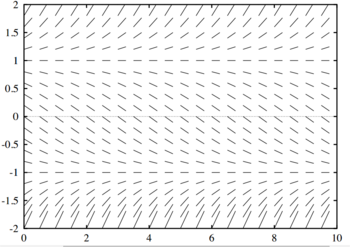Science:Math Exam Resources/Courses/MATH102/December 2013/Question A 06
{{#incat:MER QGQ flag|{{#incat:MER QGH flag|{{#incat:MER QGS flag|}}}}}}
• QA 1 • QA 2 • QA 3 • QA 4 • QA 5 • QA 6 • QA 7 • QA 8 • QB 1 • QB 2 • QB 3 • QB 4 • QB 5 • QB 6 • QB 7 • QB 8 • QC 1 • QC 2(a) • QC 2(b) • QC 2(c) • QC 2(d) • QC 3 • QC 4 •
Question A 06 |
|---|
|
The slope field shown below corresponds to which differential equation?  (a) (b) (c) (d) (e) |
|
Make sure you understand the problem fully: What is the question asking you to do? Are there specific conditions or constraints that you should take note of? How will you know if your answer is correct from your work only? Can you rephrase the question in your own words in a way that makes sense to you? |
|
If you are stuck, check the hints below. Read the first one and consider it for a while. Does it give you a new idea on how to approach the problem? If so, try it! If after a while you are still stuck, go for the next hint. |
Hint 1 |
|---|
|
How can looking for the equilibrium solutions help to find where ? |
Hint 2 |
|---|
|
Plugging in the values for a certain point on the slope field may yield some insight. |
|
Checking a solution serves two purposes: helping you if, after having used all the hints, you still are stuck on the problem; or if you have solved the problem and would like to check your work.
|
Solution |
|---|
|
We note that and appear to be equilibrium solutions, since the slope field is zero at these values. Thus and are constant solutions to the differential equation in question, i.e., . By the zero product property, it follows that contains the factors . Therefore we eliminate (A), (D), and (E). We now choose a point, say . The slope field is clearly decreasing at that point and so . Plugging into both (B) and (C) only yields a negative value with . |
{{#incat:MER CT flag||
}}















